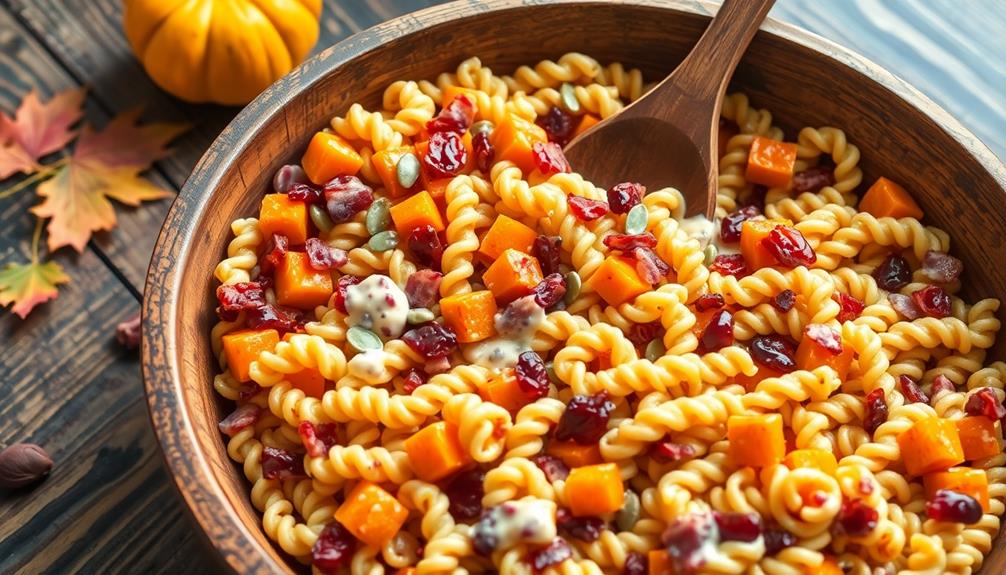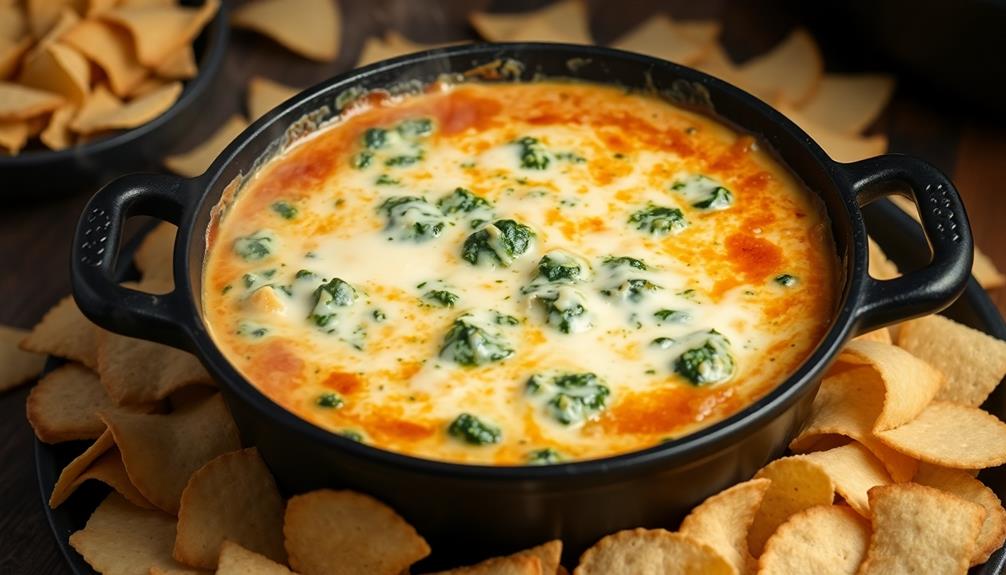Certain foods are deemed aphrodisiacs in literature due to their rich symbolism and sensory appeal. You'll find that items like oysters and figs evoke passion and intimacy, often connecting to fertility and sensuality. Historical beliefs, rooted in ancient cultures, link these foods to romantic rituals. Additionally, their textures and aromas enhance the dining experience, making meals memorable. Ingredients like chili peppers and dark chocolate even have scientifically backed effects on mood and desire. If you're curious about how these foods intertwine with cultural practices and specific rituals, there's so much more to explore.
Key Takeaways
- Aphrodisiacs, derived from Aphrodite, are substances believed to enhance sexual attraction and pleasure through historical and cultural associations.
- Foods like figs, oysters, and chocolate symbolize fertility, sensuality, and indulgence, influencing perceptions of desire in literature.
- Sensory experiences with food, such as aroma, texture, and taste, enhance intimacy and arousal during romantic encounters.
- Cultural beliefs integrate specific foods into rituals and celebrations, reinforcing their status as aphrodisiacs in various societies.
- Scientific studies suggest certain compounds in foods, like capsaicin and phenylethylamine, can positively impact mood and sexual desire.
Definition of Aphrodisiacs

When exploring the world of aphrodisiacs, you'll find these substances are often linked to an age-old desire: to stimulate sexual attraction and enhance pleasure. The term "aphrodisiac" derives from Aphrodite, the Greek goddess of love and beauty, highlighting the strong historical connection between food and romantic attraction.
You may be surprised to learn that foods considered aphrodisiacs often feature suggestive shapes, like oysters and figs, believed to symbolize sexual organs and amplify sexual desire. Various cultures also celebrate specific foods for their romantic connotations, such as the rich, creamy texture of ankimo which is often enjoyed as a luxurious appetizer, enhancing the dining experience.
Scientific research has also investigated foods containing feel-good compounds, such as capsaicin in chili peppers and phenylethylamine in chocolate. These ingredients might positively influence mood and libido, making them popular choices in the domain of aphrodisiacs.
However, it's crucial to recognize that despite the widespread belief in their effectiveness, scientific evidence supporting the claim that these foods can enhance sexual desire remains limited. Much of the support is anecdotal, relying on cultural practices and personal experiences rather than rigorous scientific validation.
Understanding the definition of aphrodisiacs helps you appreciate their role in literature and culture, where they symbolize the deep connection between food, romance, and human desire.
Historical Context of Food and Desire

The historical interplay between food and desire reveals how deeply intertwined our culinary choices have been with matters of the heart. Throughout time, certain foods like figs, oysters, and chocolate have gained a reputation for enhancing sexual desire, often due to their shape or nutritional properties.
Ancient Greeks and Romans believed that food could influence fertility, associating sensuality with items resembling human anatomy, such as asparagus and carrots. In Brazilian cuisine, for example, the use of ingredients like seafood and spices often adds a layer of richness and excitement to meals, making them perfect for romantic occasions.
This connection between food and romance is evident in ancient texts and practices, where meals featuring aphrodisiac ingredients played a vital role in courtship rituals. In the 18th and 19th centuries, literature explored the erotic potential of culinary experiences, with authors like Isabel Allende in *Aphrodite* highlighting how certain foods could evoke passion.
Moreover, the symbolic representation of food as a conduit for desire reflects societal views on sexuality and intimacy. Certain dishes became reserved for romantic encounters, enhancing the atmosphere of love and connection.
As you explore culinary history, you can't help but notice how these foods have shaped our understanding of desire and the rituals surrounding it.
Symbolic Foods in Literature

Symbolic foods in literature tantalize the senses and deepen emotional connections, often embodying themes of desire and intimacy. Throughout various narratives, foods like figs and oysters emerge as potent symbols of sexual allure, their shapes and associations with fertility stirring the imagination.
Chocolate, too, finds its place in romantic verses, representing indulgence and passion, even if the science behind its aphrodisiac properties is debatable. In Indonesian culture, dishes like Nasi Tumpeng celebrate gratitude and unity, further illustrating how food can symbolize love and connection.
Fruits such as peaches and pomegranates carry rich sexual connotations, linking their juicy textures and sweet flavors to eroticism and the intimacy of shared moments. Meanwhile, phallic foods like asparagus and eggplant illustrate cultural views on masculinity and virility, reinforcing the connection between food and sexual desire.
In literature, the act of sharing meals or cooking together serves as a metaphor for intimacy, further enhancing the narrative of certain foods as aphrodisiacs. These symbolic representations reveal how deeply intertwined food and love are, illustrating that throughout history, aphrodisiacs were sought not just for their flavor, but for their ability to evoke passion and strengthen bonds between lovers.
Sensory Experiences With Food

Food engages all five senses, creating a rich tapestry of experiences that can deepen intimacy and attraction. The sensory experiences associated with cooking and eating play an essential role in stimulating sexual arousal. The scent of fragrant dishes, like roses, can evoke powerful emotions, while the textures of oysters or chocolate can heighten physical desire.
Here's a table that highlights how each sense contributes to this culinary romance:
| Sense | Contribution |
|---|---|
| Smell | Aromas can evoke emotions and memories. |
| Sight | Vibrant colors and artistic presentations entice. |
| Taste | Unique flavors can create unforgettable moments. |
| Touch | Textures enhance the physical experience. |
| Sound | The sounds of cooking and crunching add ambiance. |
Sharing food together fosters emotional connections that enhance intimacy. Each bite becomes a shared moment, reinforcing the bond between you and your partner. By engaging all five senses, food transforms into a powerful tool for attraction, making culinary experiences a significant part of romantic relationships. So, the next time you enjoy a meal, pay attention to how these sensory experiences can ignite passion.
Cultural Practices Surrounding Aphrodisiacs

Throughout history, various cultures have celebrated specific foods as powerful aphrodisiacs, believing they can ignite passion and enhance sexual desire. You'll find that many of these foods, like oysters, figs, and chocolate, have suggestive shapes or rich nutritional content, reinforcing their reputation.
In ancient Rome, for instance, rose-infused dishes were served to rekindle romance, showcasing how culinary practices play an essential role in intimate relationships. Similarly, certain dishes like Red-Braised Pork Belly are often enjoyed during festive gatherings, emphasizing the connection between shared meals and romantic moments.
Many societies embrace foods resembling sexual organs, such as asparagus and bananas, as symbols of fertility and sexual energy. These connections reflect deeper cultural beliefs about the interplay between food and sex. Rituals and ceremonies often incorporate these aphrodisiac foods, emphasizing local customs and the significance of food in love and attraction.
Moreover, you can see this cultural significance echoed in literature and art, where the sensual qualities of certain foods are frequently depicted as intertwined with romance.
These representations highlight the crucial moral and religious dimensions of food in celebrating eroticism, suggesting that what you eat can profoundly influence your desires and connections with others.
Scientific Perspectives on Aphrodisiacs

The intriguing world of aphrodisiacs isn't just rooted in cultural beliefs—science offers insights into how certain foods can genuinely impact sexual desire and arousal. Various studies reveal that certain ingredients can enhance sexual function, providing a scientific perspective on their aphrodisiac qualities.
For example, many traditional Indian dishes, such as Mushroom Masala, incorporate rich spices that can enhance bodily sensations and contribute to an overall sense of well-being, potentially boosting libido.
For example:
- Chili Peppers: Contain capsaicin, which can heighten bodily sensations and stimulate endorphin release, possibly increasing sexual arousal.
- Oysters: Packed with zinc, they play an essential role in testosterone production, promoting overall sexual health.
- Dark Chocolate: Rich in phenylethylamine and serotonin, these compounds are linked to mood enhancement and pleasure, which can help boost libido.
- Fruits like Cherries and Pomegranates: These are high in antioxidants that improve blood flow, important for ideal sexual function.
It's also worth noting that the placebo effect greatly influences how you perceive these foods as aphrodisiacs. Your mindset can amplify their effects on sexual desire, blending both psychological and physiological factors into the experience.
Notable Aphrodisiac Ingredients

When it comes to aphrodisiacs, certain ingredients stand out for their unique properties and historical significance. These ingredients not only enhance your culinary experience but also have a storied past linked to sexual relations. Here's a closer look at some notable aphrodisiac ingredients you might want to contemplate:
| Ingredient | Key Benefit | Historical Significance |
|---|---|---|
| Oysters | High in zinc, boosts testosterone | Ancient Romans viewed them as sacred |
| Dark Chocolate | Contains phenylethylamine, enhances mood | A classic romantic gift in literature |
| Figs | Associated with fertility, suggestive shape | Symbol of sensuality in many cultures |
| Chili Peppers | Capsaicin increases heart rate | Used in love potions throughout history |
Incorporating these ingredients into your meals could spice up your sexual relations. Oysters and dark chocolate are especially popular during romantic occasions, while figs and chili peppers add both flavor and fun. Asparagus, rich in vitamin E, is said to enhance libido, making it another great choice for intimate dinners.
The Role of Food in Romance

When you think about romance, certain foods likely come to mind, each carrying its own symbolic weight.
From the sensual curves of figs to the rich allure of chocolate, these culinary delights not only excite the senses but also tap into deep cultural beliefs about love and desire.
Just like the vibrant flavors found in traditional dishes such as Chilaquiles, exploring the connection between food and romance reveals how shared meals can enhance intimacy and reflect the rituals that shape our relationships.
Symbolic Food Associations
In the domain of romance, food becomes a powerful symbol, intertwining desire and intimacy in ways that words often can't capture. Certain foods hold deeper meanings that enhance our connections with others. For instance, the shapes and colors of these foods often symbolize sexuality, linking them directly to romantic feelings. Traditional dishes like Agnolotti can evoke a sense of handmade care and affection, while the vibrant colors of a fresh pasta dish with tomato sauce can symbolize passion and warmth.
Consider the following associations:
- Oysters evoke sensuality due to their resemblance to sexual organs.
- Figs are often linked to fertility and lustful desires.
- Peaches represent femininity and softness.
- Eggplants symbolize masculinity and virility.
These symbolic food associations show how foods are considered aphrodisiacs not just for their taste, but for the emotions they evoke. Historically, chocolates and rose petals have been used to elevate romantic moments, reinforcing the notion that certain foods can enhance intimacy.
In literature, authors masterfully use culinary imagery to create scenes that resonate with sensuality, drawing readers into the emotional depths of their characters. This intricate relationship between food, desire, and romance reveals how deeply rooted our cultural perceptions of aphrodisiacs truly are, shaping the way we experience love and attraction through shared meals. In many narratives, the act of preparing or sharing food becomes a metaphorical dance, a language of intimacy that speaks louder than words. Florence Pugh’s cooking journey, often shared with her audience, exemplifies how the act of creating a meal can bridge emotional gaps and foster connection, much like in literature where culinary moments intertwine with vulnerability. Whether through the aromatic stir of spices or the quiet exchange of glances over a shared dish, food becomes a vessel for storytelling, love, and longing.
Sensory Experiences in Cooking
Cooking transforms mere ingredients into a multisensory journey that deepens connections between partners. Engaging all five senses—smell, sight, taste, touch, and sound—creates a rich sensory experience that elevates intimacy and attraction. The aroma of certain foods, like roses, can stir feelings of arousal, as scent is deeply tied to emotional connections.
For instance, the enticing aroma of traditional Ethiopian dishes like Yekolo (Roasted Barley) can evoke a comforting and inviting atmosphere that enhances romantic encounters.
When you whip up creamy chocolates or bite into juicy fruits, the sensual textures evoke pleasurable sensations that enhance romantic moments. Imagine sharing the task of cooking; that collaboration not only fosters communication but also strengthens your bond, allowing you to connect on a deeper level.
Visual presentation matters, too. Vibrant colors and artistic plating can make a meal not just food, but a feast for the eyes, enhancing the overall dining experience. You're not just consuming a meal; you're creating memories that linger well beyond the last bite.
In this way, the act of cooking together becomes a catalyst for arousal and intimacy, reminding you that food is more than sustenance—it's an integral part of romance.
Cultural Beliefs and Practices
Throughout history, food has played a pivotal role in romance across various cultures, often seen as a vehicle for expressing love and desire. Many societies have embraced certain foods as aphrodisiacs, linking them to fertility and passion. This belief is deeply rooted in cultural traditions that celebrate love with specific ingredients.
For instance, creative dishes like Graveyard Taco Dip can add a playful yet intimate touch to romantic gatherings. Consider these examples of foods commonly associated with romance:
- Oysters: Believed to enhance desire due to their suggestive shape and nutritional benefits.
- Chocolate: A symbol of love often shared on Valentine's Day.
- Rose-infused dishes: Used in ancient Rome to rekindle romance, showing how scents can enhance experiences.
- Honey and wine: Frequently included in wedding ceremonies, symbolizing sweetness and fertility.
These foods not only tantalize the taste buds but also create an atmosphere of intimacy. They've woven themselves into rituals, folklore, and intimate occasions, reinforcing how the culinary world influences our perceptions of attraction and desire.
Frequently Asked Questions
What Makes Certain Foods Aphrodisiacs?
Certain foods are deemed aphrodisiacs because they stimulate your senses, evoke pleasurable memories, and may contain nutrients that boost libido. Their enticing aromas and appealing presentations can enhance your romantic and intimate experiences.
Why Are Aphrodisiacs Called Aphrodisiacs?
Aphrodisiacs are called so because they're linked to Aphrodite, the Greek goddess of love. You'll find that many foods associated with desire and pleasure have historical significance, enhancing romance in various cultures throughout time.
Is There Any Scientific Basis for Aphrodisiacs?
You might think aphrodisiacs hold the secret to irresistible passion, but scientific evidence is sparse. While some foods could boost mood, it's often psychological factors that drive desire, not magical compounds in those tempting treats.
What Are the Top Three Aphrodisiacs?
The top three aphrodisiacs you might enjoy are oysters, dark chocolate, and chili peppers. Oysters boost testosterone, dark chocolate lifts your mood, and chili peppers can ignite your senses, enhancing your romantic experiences.
Conclusion
As you savor the delightful flavors that have enchanted lovers throughout history, remember that food isn't just nourishment; it's a powerful symbol of passion. Like the legendary feast from Shakespeare's plays, where every bite ignites desire, the aphrodisiac qualities of certain foods can elevate your romantic encounters. So, embrace the magic of these culinary delights, and let them weave their enchanting spell, reminding you that love, much like a fine meal, is best when savored together.









